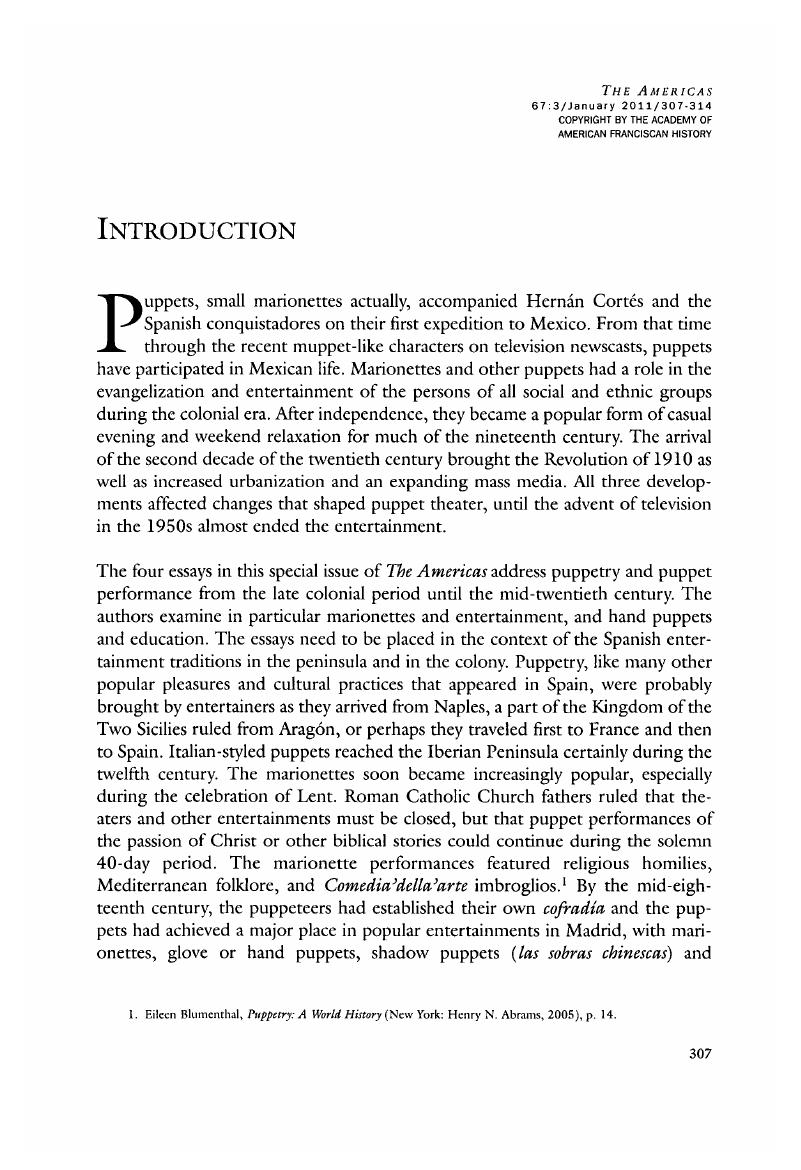Article contents
Introduction: Mexican Puppets as Popular and Pedagogical Diversions
Published online by Cambridge University Press: 17 February 2015
Abstract

- Type
- Introduction
- Information
- Copyright
- Copyright © Academy of American Franciscan History 2011
References
1. Blumenthal, Eileen, Puppetry: A World History (New York: Henry N. Abrams, 2005), p. 14.Google Scholar
2. Varey, J.E., Historia de los titeres en España (desde sus origines hasta mediados del siglo XVIII) (Madrid: Revista de Occidente, 1957), pp. 8–9, 99, 107;Google Scholar Titeres, marionetas y otras diversiones populares de 1758 a 1859 (Madrid: Instituto de Estudios Madrileños, 1959), p. 8, passim.
3. Ramírez Alvarado, Gilberto, “Los títeres en México durante la colonia, del siglo XVI al XIX,” La hoja del titiritero Independiente (1990), p. 13;Google Scholar the quoted description comes from Yolanda Jurado Rojas’s essay, “Puppet Theater in Eighteenth–Century Mexico”; http://es.wikipedia.org/wiki/Polichinela
4. Doudoroff, Michael J., ed., Moros y Cristianos en Zacatecas: Text of a Mexican Folk Play (Lawrence, KS: Amadeo Conca Press, 1981).Google Scholar
5. McPharlan, Paul, The Puppet Theatre in the Americas: A History (New York: Harper and Brothers, 1949), pp. 6, 7, 70.Google Scholar
6. Luis, Reyes de la Maza, El teatro en Mexico en la época de Juárez (1868–1872) (México: Instituto de Investigaciones Estéticas, UNAM, 1961), pp. 19–20.Google Scholar
7. Beezley, William H., “Cómo fue que El Negrito salvó a Mexico de los franceses: las fuentes populares de la identidad nacional,” Historia Mexicana, no. 226 (Octubre–Diciembre, 2007), pp. 405–444.Google Scholar
8. The diversity of popular entertainments across the nation can be appreciated by consulting the municipal licensing records, usually identified as “diversiones públicas,” in local archives. For various solitary and group puppeteers, see Cabrera, Sonia Iglesias and Prisant, Guillermo Murray, Piel de papel, manos de palo: Historia de los títeres en México (México: Espasa-calpc Mexicana, 1995).Google Scholar
9. Beezley, William H., Mexican National Identity: Memory, Innuendo, and Popular Culture (Tucson: University of Arizona Press, 2008), pp. 98–145.Google Scholar
10. This composition was widely-known in the United States from 1955 to 1962 as the theme to the television program “Alfred Hitchcock Presents.” My thanks to Jennifer Jenkins, from the Department of English at the University of Arizona for this information.
11. Schafer, R. Murray, The Tuning of the World (New York: Alfred A. Knopf, 1977), pp. 3–123.Google Scholar
12. The song was released on her obscure album, Pa’ Morirse de Amor (EMI, 1997). Sandra Muñoz provided this information.
13. Kristin Ruggiero from the University of Wisconsin-Milwaukee provided this information.
14. See the Manicomio de muñecos offiicial Website, http://www.manicomiodcmunecos.com/ and http://www.matacandelas.com/temporada.htm for the porno puppet group. My thanks to Paula Barreiro at La Universidad de Medellín for suggestions about these contemporary groups. Advertisements appear regularly in El Colombiano, the local newspaper. See Oct. 21, 1985 as an example.
15. See the chapter “Puppet Policy: Marionettes and Muñecos as Teaching Tools in Chile, 1970–1973” in the forthcoming dissertation, Korowin, Erika M., “Crafting a New Nation: Cultural Politics on the Chilean Road to Socialism, 1970–1973” (University of Arizona).Google Scholar
- 1
- Cited by


